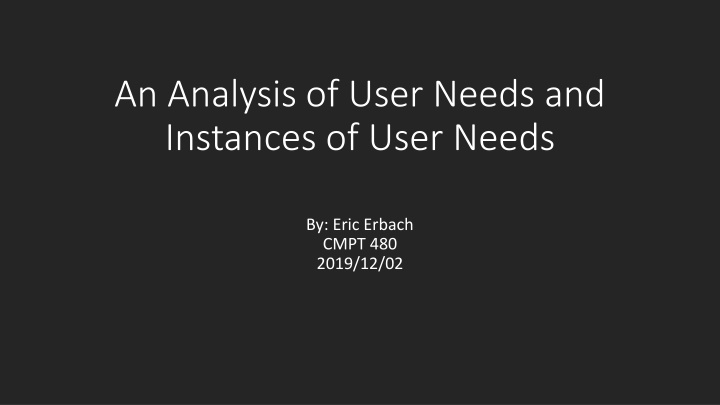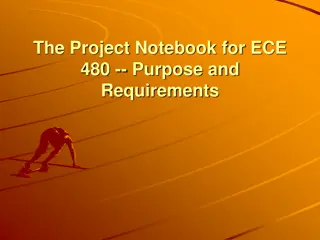
User Needs Analysis and Instances: Insights and Challenges
Discover the significance of identifying and meeting user needs for system accessibility. Explore the process of extracting new needs and instances from ISO 29138-1, highlighting key findings and encountered obstacles in the field of accessibility research. Uncover the results of the project, showcasing new user needs and instances identified along with valuable insights gained throughout the process.
Download Presentation

Please find below an Image/Link to download the presentation.
The content on the website is provided AS IS for your information and personal use only. It may not be sold, licensed, or shared on other websites without obtaining consent from the author. If you encounter any issues during the download, it is possible that the publisher has removed the file from their server.
You are allowed to download the files provided on this website for personal or commercial use, subject to the condition that they are used lawfully. All files are the property of their respective owners.
The content on the website is provided AS IS for your information and personal use only. It may not be sold, licensed, or shared on other websites without obtaining consent from the author.
E N D
Presentation Transcript
An Analysis of User Needs and Instances of User Needs By: Eric Erbach CMPT 480 2019/12/02
Justification All users have some needs in some contexts These needs need to be met in order for a system to be accessible Developers need to know of needs in order to meet them However, not all needs are known Thus, in order to aid accessibility, more needs need to be identified
Analysis The major source of information was ISO 29138-1 ISO 29138-1 contains a detailed list of user needs and instances of user needs The entire project revolves around this document
Implementation I The main way I went about finding new needs and instances went as follows: Read through section of ISO 29138-1 Write down ideas for new needs and instances Read through again Add any new instances found, and delete any that turned out to be redundant Scour the internet to see if any data backed up the new items Repeat for each section
Implementation II Throughout the course of the project, three major problems were encountered when finding new items: First, the field of accessibility is still growing and thus there are not many studies in some of the more niche areas of it I have an item about error severity, but I was unable to find any studies about the importance of it Secondly, many scholarly sources can not be freely accessed Lastly, sometimes terminology used in accessibility is similar to that used in other fields Searching for transcripts in google scholar brings up many papers on RNA and the human genome
Results I At this stage in the project, I have been able to identify three new user needs and ten new instances of user needs Additionally there are an additional six items comprising six new instances of user needs and one new user need from the class slides I do not have time to cover all of these, so I will cover some of the more interesting needs and instances identified
Results II A new need was found in class for the second principle, Needs related to the conformity of user expectations It was found by Eileen and can be seen on slide 30 of the chapter 4 slides It is the need To be reinforced when using the system It has three instances: a) to have one's expectations confirmed when using the system b) to be reassured that the user's actions are acceptable and being acted upon correctly c) to be engaged using appropriate affective characteristics
Results III New instance of user need 3-3 To have simultaneous use of alternate interaction modalities The new instance was: 3-3-d to be able to receive output in both tactile and audio modalities simultaneously when interacting with otherwise visual information For example, some users might need to use a vibro-audio feedback system in order to read a map if they are unable to see it Based on: Giudice, Nicholas A., et al. "Learning non-visual graphical information using a touch-based vibro-audio interface."
Results IV New instance of user need 4-6 To avoid patterns that cause psychological or physical discomfort or disturbance The new instance was: 4-6-c to avoid movement patterns that cause seizures The need identified that some visual and audio patterns could cause seizures, but not that some movement patterns could Discussed in this study Pierelli, F., et al. "Movement Induced Seizures: A Case Report." Epilepsia 38.8 (1997): 941-944.
Results V A new need I found belongs within the seventh principle, Needs related to controllability It is: 7-4-6 to be able to create and modify macros Some users have limited input ability, and being able to control their controls (with macros) would allow them to access systems which require many inputs Based on: Rodrigues, Andr . "Breaking Barriers with Assistive Macros." Proceedings of the 17th International ACM SIGACCESS Conference on Computers & Accessibility. ACM, 2015.
Results VI The results of this project have been evaluated by the instructor The project has been updated in accordance with the feedback received However, there is still more evaluation to be done Self-evaluation will involve enhancing some of the weaker items and adding new ones, especially those from sections which were not analyzed Proof by example will involve finding real world examples of each of the needs and instances identified
Conclusion This project can be useful and will hopefully help establish more needs which users have However, there is still more work to be done There still needs to be a self-evaluation and proof by cases Some of the items need further research to be worth proper consideration Some items need to be worded such that they better convey the need




